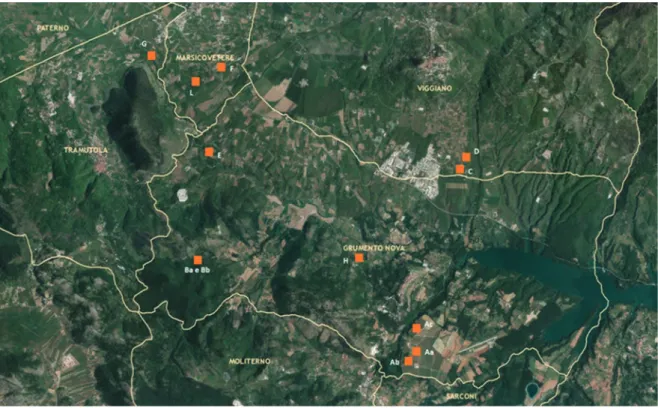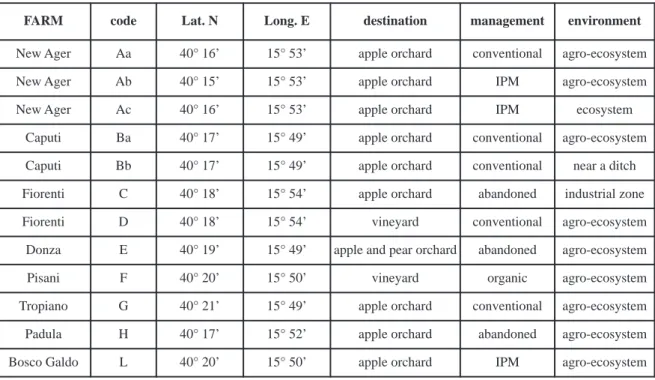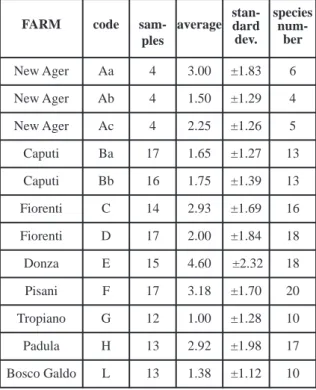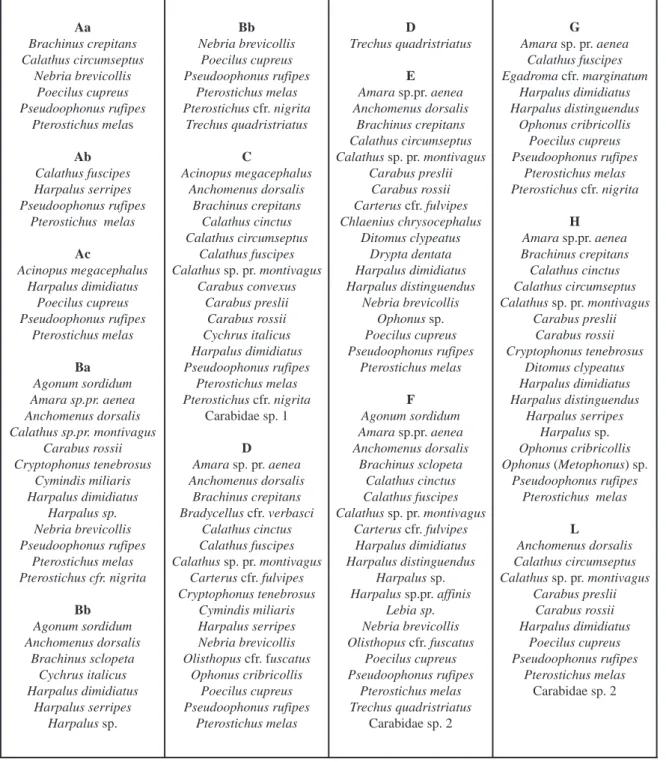Species composition of carabid communities (Coleoptera
Carabidae) in apple orchards and vineyards in Val d’Agri
(Basilicata, Italy)
Agostino Letardi*, Silvia Arnone, Massimo Cristofaro & Paola Nobili
ENEA, Unità Tecnica sviluppo sostenibile ed innovazione del sistema agroindustriale - Laboratorio gestione sostenibile degli agro-ecosistemi -Via Anguillarese 301, 00123 Rome, Italy
*Corresponding author, e-mail: [email protected]
ABSTRACT An entomological investigation was carried out in an agricultural area, mainly apple orchards, of the Agri river plain, located in some municipalities of Basilicata, Italy. Between 2012 and 2014, species richness and composition of carabid assemblages were investigated on the ground surface of differently managed (abandoned, organic, commercial and IPM) apple orchards and vineyards. Ground beetles (Coleoptera Carabidae) were sampled by means of pitfall traps. 1288 individuals belonging to 40 species were collected, representing two-thirds of the carabid fauna of this area found in our and earlier studies. The species richness varied between 4 and 20 in the different orchards. The common species, occurring with high relative abundance in the individual orchards in decreasing order were: Ptero-stichus (Feronidius) melas (Creutzer, 1799), Pseudoophonus (Pseudoophonus) rufipes (De Geer, 1774), Brachinus crepitans (Linnaeus, 1758), Harpalus (Harpalus) dimidiatus (P. Rossi, 1790) and Poecilus (Poecilus) cupreus (Linnaeus, 1758). Most of the collected ground beetles were species with a wide distribution in the Paleartic region, eurytopic and common in European agroecosystems. The assemblages were dominated by small-medium, macropterous species, with summer larvae. No endemic species were found.
KEY WORDS ground beetle; pitfall trapping; bioindicators; conservation; agro-ecosystem management. Received 18.12.2014; accepted 26.01.2015; printed 30.03.2015
INTRODUCTION
In the frame of the ENEA project AGRIVAL (aree AGRIcole ad alto VALore naturalistico dell’alta val d’Agri = high nature value farmland in upper Val d’Agri) (Menegoni et al., 2012, 2014), an entomological investigation was carried out in an agricultural area, apple orchards and vineyards, of the Agri river plain, located in the municipalities of Marsico V., Tramutola, Grumento N. and Viggiano (Potenza, Basilicata, Italy).
The aim of this research was to investigate the Carabid assemblages. In Europe several studies
gave faunal data on similar agro-ecosystems inhab-iting carabids (Kutasi et al., 2004); these studies indicate that variations in cultivation management leads to variations in carabid beetle assemblages. Although the spatial distribution of carabid beetles may be primarily determined by microhabitat con-ditions and biotic interactions at the local scale, identifying general patterns of carabid responses to different agro-ecosystem managements may help to understand how species, functional groups and as-semblages effectively distribute, and to predict how they will cope with current and future land-use and climatic changes (Brandmayr et al., 2011; Kotze et
al., 2011). In previous studies in Europe the fol-lowing species were mentioned as common (Kutasi et al., 2004): Pseudoophonus rufipes (De Geer, 1774), Harpalus distinguendus (Duftschmid, 1812),
Harpalus tardus (Panzer, 1796), Nebria brevicollis
(Fabricius 1792), Pterostichus melanarius (Illiger, 1798), Poecilus cupreus (Linnaeus, 1758), Harpalus
affinis (Schrank, 1781).
MATERIAL AND METHODS
Five traps were activated for a week every month in 12 sampling locations, from May until October. Sampling started on July, 2012 and ended on October, 2014. Locations have been selected according to the type of crop (10 apple orchards and 2 vineyards) and the managing practices (traditional, integrated and organic) (Fig. 1, Table 1). Due to logistic unpredictable problems, some of the locations selected at the beginning of the experiment (samples Aa, Ab and Ac) were not suitable anymore, and since 2013 were displaced with analogous locations, respectively samples G, H and L.
Ground beetles were sampled using plastic pit-fall traps (500 ml and 100 mm the diameter of the top) buried in the soil and filled with 50 ml salt water. Pitfalls were covered with a 10 × 10 cm plastic roof to prevent flooding.
The qualitative and quantitative data of the carabid assemblages, recorded in the orchards of the selected areas of Val d’Agri, were analyzed in three different ways: 1) the weighted average of different species in the total catch of the 12 samples; 2) the sum of the scores was calculated (where the most abundant species collected in an orchard were placed in decreasing order, and the dominant species, with highest relative abundance scored 8, the second one 7 etc.; the scores from different orchards were summarised by species: the highest possible score, if a species was dominant in all orchards, was [12 × 8] 96); 3) the presence or ab-sence of the species in the orchards was also in-vestigated. The most widely distributed species (which were found in 12 of the 12 investigated orchards) got 100%; the species, which was collec-ted in 9 orchards, got 75% etc.
Carabids were identified to the species level, if possible, following the nomenclature of Fauna
Europaea (Vigna-Taglianti, 2013). Specimens, pre-served in alcohol, are stored in the collection of the ENEA Casaccia research centre.
RESULTS
Overall, 1,288 individuals have been collected belonging to 40 carabid species which represent, according to our elaboration of the available data (Casale et al., 2006; Letardi et al., 2014a,b), two thirds of the total carabid fauna reported for this geographic area. The species richness of the invest-igated carabid assemblages ranged between 4 and 20 in the different orchards: the weighted averages of different species in each samples were not stat-istically significantly different, nevertheless they show an evident tendency to increase in terms of biodiversity moving from conventional manage-ment farms towards organic and semi-abandoned, re-naturalized ones (Table 2). The relatively high biodiversity value in the conventional managed farm New Ager (Aa) could be an exception due to the very few number of samples (just 4, all during 2012) collected: in 2013 and 2014 it was not pos-sible to sample inside the New Ager farm, due to technical logistic impediments.
Qualitative and quantitative data analyses have been performed among the collected carabid species following 3 methods: their proportion in the total catch of the investigated orchards; the scoring of the seven commonest species in the different orchards (total scores) and their presence in the orchards (distribution).
The most abundant species was Pterostichus
melas (33%) followed by Pseudoophonus rufipes
(20%), Brachinus crepitans (14%), Harpalus
di-midiatus (8%) and Poecilus cupreus (6%). The
species which dominated the carabid assemblages (with the total scores) were Pterostichus melas (80),
Pseudoophonus rufipes (79), Harpalus dimidiatus
(45), Poecilus cupreus (18), Brachinus crepitans (14), Carabus rossii Dejean, 1826 (11) and
Calathus fuscipes (Goeze, 1777) (10) (Table 3). Pterostichus melas and Pseudoophonus rufipes
were found in all investigated samples (100%),
Harpalus dimidiatus was found in the 75% of the
different habitats, Poecilus cupreus was found in the 67%, Anchomenus dorsalis (Pontoppidan, 1763) and Calathus sp. pr. montivagus Dejean, 1831 were found in the 58%, while Amara sp. pr.
aenea (De Geer, 1774) and Nebria brevicollis
(Fabricius, 1792) were also quite common (50%). FARM code Lat. N Long. E destination management environment
New Ager Aa 40° 16’ 15° 53’ apple orchard conventional agro-ecosystem
New Ager Ab 40° 15’ 15° 53’ apple orchard IPM agro-ecosystem
New Ager Ac 40° 16’ 15° 53’ apple orchard IPM ecosystem
Caputi Ba 40° 17’ 15° 49’ apple orchard conventional agro-ecosystem
Caputi Bb 40° 17’ 15° 49’ apple orchard conventional near a ditch
Fiorenti C 40° 18’ 15° 54’ apple orchard abandoned industrial zone
Fiorenti D 40° 18’ 15° 54’ vineyard conventional agro-ecosystem
Donza E 40° 19’ 15° 49’ apple and pear orchard abandoned agro-ecosystem
Pisani F 40° 20’ 15° 50’ vineyard organic agro-ecosystem
Tropiano G 40° 21’ 15° 49’ apple orchard conventional agro-ecosystem
Padula H 40° 17’ 15° 52’ apple orchard abandoned agro-ecosystem
Bosco Galdo L 40° 20’ 15° 50’ apple orchard IPM agro-ecosystem
It can be concluded that four species
Ptero-stichus melas, Pseudoophonus rufipes, Harpalus dimidiatus and Poecilus cupreus were among the
commonest species in the investigated samples in respect of all three approaches.
DISCUSSION
Altogether, as a result of our investigations, 40 carabid species, representing about two-thirds of the whole carabid fauna reported in this area in our and previous studies (Casale et al., 2006), were found in apple orchards and vineyards of the medium area of the Agri river plain.
Most of the collected carabids, both in the whole area and in each sample, were species with a wide distribution in the Paleartic region, eurytopic and common in European agroecosystems.
The assemblages were dominated by small-medium, macropterous species, with summer l arvae; we didn’t find any endemism (Table 4). FARM code
sam-ples
average stan-dard dev. species num-ber New Ager Aa 4 3.00 ±1.83 6 New Ager Ab 4 1.50 ±1.29 4 New Ager Ac 4 2.25 ±1.26 5 Caputi Ba 17 1.65 ±1.27 13 Caputi Bb 16 1.75 ±1.39 13 Fiorenti C 14 2.93 ±1.69 16 Fiorenti D 17 2.00 ±1.84 18 Donza E 15 4.60 ±2.32 18 Pisani F 17 3.18 ±1.70 20 Tropiano G 12 1.00 ±1.28 10 Padula H 13 2.92 ±1.98 17 Bosco Galdo L 13 1.38 ±1.12 10
Table 3. Relative abundance (%) and the total scores of the most abundant carabid species. Relative abundance lower than 5% were marked with +.
species Aa Ab Ac Ba Bb C D E F G H L Total score P. melas + 14.3 7.3 41 6.2 21.2 62.6 41.2 18.8 52.3 15.9 57.8 80 P. rufipes 46.2 28.6 87.8 6.4 87.7 50 10.1 7.4 12.5 8.1 5.7 15.6 79 H. dimidiatus 37.1 5.1 + 14.4 13.1 23.5 + 8.1 6.3 45 P. cupreus 43.1 + + + 10.3 + 7.2 + 18 B. crepitans + 6.4 + + 50.5 14 C. rossii 9 + + 28.1 + 11 C. fuscipes + + 5.2 10.5 + 10 A. aenea + + + 5.8 + + 5 C. convexus 10.4 5 D. clypeatus 5.1 + 4 O. cribricollis + 5.1 + 4 C. preslii + + 5.2 + 3 specimen n° 65 35 41 78 65 52 99 68 96 86 333 270 species n° 6 10 4 17 5 10 13 13 16 18 18 20
The common species in agro-environments investigated were the same as those usually found in field crops and which can be considered as “disturbance-tolerant” species.
The number of captures, qualitative and quantit-ative data here reported have shown a clear
tendency to be more abundant moving from con-ventional towards to organic managements, not sup-ported by a solid statistical analysis; therefore sampling more distributed in terms of time and rep-licates would be necessary to provide more suitable data. Aa Brachinus crepitans Calathus circumseptus Nebria brevicollis Poecilus cupreus Pseudoophonus rufipes Pterostichus melas Ab Calathus fuscipes Harpalus serripes Pseudoophonus rufipes Pterostichus melas Ac Acinopus megacephalus Harpalus dimidiatus Poecilus cupreus Pseudoophonus rufipes Pterostichus melas Ba Agonum sordidum Amara sp.pr. aenea Anchomenus dorsalis Calathus sp.pr. montivagus Carabus rossii Cryptophonus tenebrosus Cymindis miliaris Harpalus dimidiatus Harpalus sp. Nebria brevicollis Pseudoophonus rufipes Pterostichus melas Pterostichus cfr. nigrita Bb Agonum sordidum Anchomenus dorsalis Brachinus sclopeta Cychrus italicus Harpalus dimidiatus Harpalus serripes Harpalus sp. Bb Nebria brevicollis Poecilus cupreus Pseudoophonus rufipes Pterostichus melas Pterostichus cfr. nigrita Trechus quadristriatus C Acinopus megacephalus Anchomenus dorsalis Brachinus crepitans Calathus cinctus Calathus circumseptus Calathus fuscipes Calathus sp. pr. montivagus Carabus convexus Carabus preslii Carabus rossii Cychrus italicus Harpalus dimidiatus Pseudoophonus rufipes Pterostichus melas Pterostichus cfr. nigrita Carabidae sp. 1 D Amara sp. pr. aenea Anchomenus dorsalis Brachinus crepitans Bradycellus cfr. verbasci Calathus cinctus Calathus fuscipes Calathus sp. pr. montivagus Carterus cfr. fulvipes Cryptophonus tenebrosus Cymindis miliaris Harpalus serripes Nebria brevicollis Olisthopus cfr. fuscatus Ophonus cribricollis Poecilus cupreus Pseudoophonus rufipes Pterostichus melas D Trechus quadristriatus E Amara sp.pr. aenea Anchomenus dorsalis Brachinus crepitans Calathus circumseptus Calathus sp. pr. montivagus Carabus preslii Carabus rossii Carterus cfr. fulvipes Chlaenius chrysocephalus Ditomus clypeatus Drypta dentata Harpalus dimidiatus Harpalus distinguendus Nebria brevicollis Ophonus sp. Poecilus cupreus Pseudoophonus rufipes Pterostichus melas F Agonum sordidum Amara sp.pr. aenea Anchomenus dorsalis Brachinus sclopeta Calathus cinctus Calathus fuscipes Calathus sp. pr. montivagus Carterus cfr. fulvipes Harpalus dimidiatus Harpalus distinguendus Harpalus sp. Harpalus sp.pr. affinis Lebia sp. Nebria brevicollis Olisthopus cfr. fuscatus Poecilus cupreus Pseudoophonus rufipes Pterostichus melas Trechus quadristriatus Carabidae sp. 2 G Amara sp. pr. aenea Calathus fuscipes Egadroma cfr. marginatum Harpalus dimidiatus Harpalus distinguendus Ophonus cribricollis Poecilus cupreus Pseudoophonus rufipes Pterostichus melas Pterostichus cfr. nigrita H Amara sp.pr. aenea Brachinus crepitans Calathus cinctus Calathus circumseptus Calathus sp. pr. montivagus Carabus preslii Carabus rossii Cryptophonus tenebrosus Ditomus clypeatus Harpalus dimidiatus Harpalus distinguendus Harpalus serripes Harpalus sp. Ophonus cribricollis Ophonus (Metophonus) sp. Pseudoophonus rufipes Pterostichus melas L Anchomenus dorsalis Calathus circumseptus Calathus sp. pr. montivagus Carabus preslii Carabus rossii Harpalus dimidiatus Poecilus cupreus Pseudoophonus rufipes Pterostichus melas Carabidae sp. 2
ACKNOWLEDGEMENTS
We wish to thank a large number of entomolo-gical colleagues of a web forum (www. entomologiitaliani.net; M. Agosti, L. Badoei, S. Biondi, S. Cosimi, S. A. Degiovanni, F. Di Giovanni, L. Forbicioni, G. Franzini, M. Gigli, G. Giovagnoli, M. Grottolo, P. Leo, C. Manci, J. Matejiecek, V. Monzini, M. Pavesi, A. Petrioli, N. Pilon, R. Rattu, R. Sciaky, M. Selis and F. Turchetti) for their help and suggestions; the owners of the farms where the study took place; Camilla Nigro, Piera Damiani and Giuseppe Sassano, of the ALSIA station of Villa d’AGRI (Italy), for their great sup-port in field work The study was carried out in the framework of AGRIVAL Project funded by Italian Government Grant according to Legge Finanziaria 2010, Agroalimentare art. 2 comma 44.
REFERENCES
Brandmayr P., Zetto T. & Pizzolotto R., 2005. I Coleotteri Carabidi per la valutazione ambientale e la conser-vazione della biodiversità. APAT, Manuali e linee guida, 34. I.G.E.R. srl, Roma, 240 pp.
Casale A., Vigna Taglianti A., Brandmayr P. & Colombetta G., 2006. Insecta Coleoptera Carabidae (Carabini, Cychrini, Trechini, Abacetini, Stomini, Pterostichini). In: Ruffo S. & Stoch F. (Eds.), 2006. Ckmap (Checklist and distribution of the italian fauna). Memorie del Museo storia naturale Verona, 2. serie, sezione scienze della vita, 17: 159–164, with data on CDrom.
Kotze DJ., Brandmayr P., Casale A., Dauffy-Richard E., Dekoninck W., Koivula MJ., Lövei GL., Mossakow-ski D., Noordijk J., Paarmann W., Pizzolotto R., Saska P., Schwerk A., Serrano J., Szyszko J., Taboada A., Turin H., Venn S., Vermeulen R. & Zetto T., 2011. Forty years of carabid beetle research in Europe – from taxonomy, biology, ecology and population studies to bioindication, habitat assessment and conservation. In: Kotze DJ., Assmann T., Noordijk J., Turin H. & Vermeulen R. (Eds.), 2011. Carabid Bee-tles as Bioindicators: Biogeographical, Ecological
and Environmental Studies. ZooKeys 100: 55-148. doi: 10.3897/zookeys.100.1523
Kutasi C.S., Marko V. & Balog A., 2004. Species composition of carabid (Coleoptera: Carabidae) communities in apple and pear orchards in Hungary. Acta Phytopathologica et Entomologica Hungarica 39: 71–89.
Letardi A., Arnone S., Cristofaro M., Nobili P., Damiani P., Nigro C., Sassano G. & Menegoni P., 2014a. Carabidofaune in meleti e vigneti in Val d’Agri. In: Mannu R. (Ed.), 2014. Poster del XXIV Congresso Nazionale Italiano di Entomologia, Orosei (Sarde-gna), 9–14 Giugno 2014: 90.
Letardi A., Arnone S., Cristofaro M., Nobili P., Damiani P., Sassano G., Nigro C. & Menegoni P., 2014b. Carabidofauna per la valutazione di agroecosistemi ad alto valore naturalistico: un caso studio in Val d’Agri. In: Alba E., Benedetti A., Bucci G., Ciaccia C., Pacucci C., Pinzari F. & Scarascia Mugnozza G. (Eds.), 2014. Atti del X Congresso Nazionale sulla Biodiversità. CNR (Roma, Italy) 3–5 Set 2014. Abstract-book, Paper #c7.15. [online] URL: http://www.sisef.it/xbio/
Menegoni P., Iannetta M., Giordano L., Iannilli V., Sighicelli M., Colucci F., Tronci C., Trotta C., Cristofaro M., Letardi A., Rapagnani M.R., Arnone S., Musmeci S., Nobili P., Ponti L., Imperatrice A., Sassano G. & Damiani P., 2014. Il progetto AGRI-VAL: aree AGRIcole ad alto VALore naturalistico dell’alta val d’Agri. In: Colucci F., Menegoni P., Trotta C., 2014. Natura 2000 in Basilicata: percorsi di “contaminazione” tra natura, scienza, arte e cultura dei luoghi. Atti del Convegno di Aliano (Matera), 4–6 aprile 2013. ENEA: 131.
Menegoni P., Iannetta M., Giordano L., Iannilli V., Sighicelli M., Colucci F., Tronci C., Trotta C. & Letardi A., 2012. Il progetto AGRIVAL “Aree agricole ad alto valore naturalistico: dalla indi-viduazione alla conservazione”, una visione del rapporto tra agricoltura e biodiversità nella conver-genza delle politiche agricole ed ambientali. IX Convegno Nazionale sulla Biodiversità, Valenzano (BA), 6–7 Settembre 2012. 34.
Vigna-Taglianti A., 2013. Fauna Europea: Carabidae. Fauna Europaea version 2.6. URL: http://www. faunaeur.org



